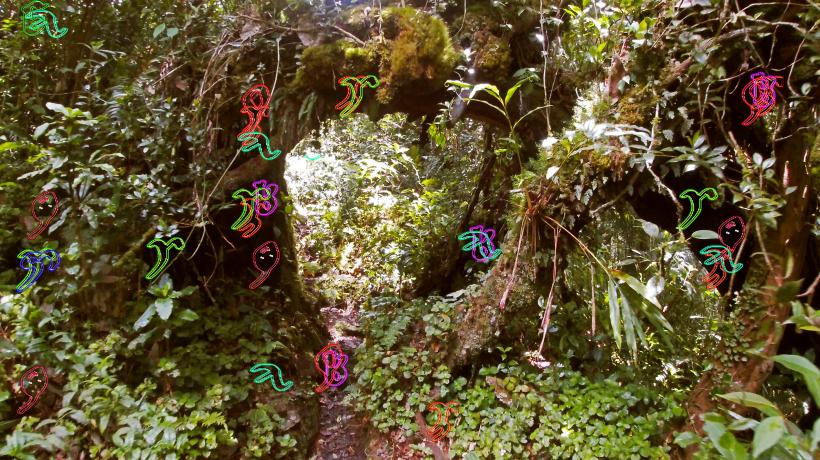
The Botanical Mind Online
6 May – 31 July 2020
Camden Art Centre | www.botanicalmind.online
Review by Aidan Kelly Murphy
‘The Botanical Mind: Art, Mysticism and The Cosmic Tree’ was originally intended to be an in-house group exhibition at Camden Art Centre. Instead, the spread of COVID-19 and the closure of public gallery spaces saw the show move to the digital realm and become ‘The Botanical Mind Online’. The exhibition is hosted at botanicalmind.online, which serves as both the main space to read about the themes and topics of the show, and the central repository for a number of digital offerings, from videos, sound recordings, and podcasts to texts.
The website’s layout is crisp, simple, and easy to use. An introduction video provides a choice of six chapters: ‘The Cosmic Tree’, ‘Sacred Geometry’, ‘Indigenous Cosmologies’, ‘Astrological Botany’, ‘As Within, So Without’, and ‘Vegetal Ontology’. Each chapter has its own page which, broadly speaking, follows a similar structure: a summary text is followed by examples of related pre-20th century artwork and literature, before showing artwork showcased or newly commissioned for ‘The Botanical Mind’. The site is curated in a way that mirrors the rooms of a large exhibition space, encouraging viewers to follow a linear path from A to B to C, with the bottom of each page providing links to the next chapter.
These six chapters approach different aspects of the show’s central theme: “investigating the significance of the plant kingdom to human life, consciousness and spirituality across cultures and through time.” Their presentations are not mutually exclusive, but offer overlapping and complementary responses to different strands of the show’s premise; concepts raised in one can be closed or expanded in another, helping the chapters gel as a successful narrative arc. We begin with ‘The Cosmic Tree’, which lays the foundations for the subsequent chapters. Here, we are reminded of the importance of the tree as a recurring motif through different religions and cultures, from the Norse Yggdrasil to the Islamic Tree of Immortality. The Swiss psychoanalyst Carl Jung anchors this section, with his lush illustrations of trees and mandalas created during a series of mind experiments he undertook after his break from Freud. We are also introduced to our first contemporary artist, with three projects by German multi-disciplinarian Andrea Büttner: ‘Moss / Littleness’ (2013), ‘Potato’ (2019) and ‘Biodynamic Agriculture and National Socialism’ (2019-20) – the middle of which includes an excellent short text by Swedish artist Malin Ståhl. Büttner interrogates our misunderstanding of plants in the first two, looking at the often, and incorrectly, simplified narratives of the life cycles and uses of mosses and potatoes.

Artist : Joachim Koester
Title : Untitled (Cannabis)
Date(s) : 2019
Material : Silver gelatin print
Website : https://www.botanicalmind.online/
Credit : Courtesy the artist and Galleri Nicolai Wallner, Copenhagen
The second half of the exhibition opens with ‘Astrological Botany’, focusing upon a notion that the universe is structured in much the same way as music which fell out of favour during the Enlightenment. These structures are represented by two contrasting, but fundamentally similar, modes of artistic expression. The first comprises Ithell Colquhoun and Kerstin Brätsch, who incorporate the symbols and patterns of nature within their work. The second addresses those who search for these symbols and patterns within nature, including Adam Chodzko, whose newly commissioned work ‘you happy roots, branch and mediatrix’ (2020) scans the forest floor for ciphers of a 12th century codex.
The penultimate chapter is titled ‘As Within, So Without’, which sees Jung and his mandalas reappear as the exhibition highlights elements of psychedelia through videos and ink blots by Bruce Connor, and drawings by Annie Besant and Charles Leadbeater, among others. Here, psychedelic drugs are shown not as an escape, but as a series of tools. The notion of the healing powers of psychedelics and other drugs has done a 360 degree spin in recent years, with substances like MDMA now used in assisting psychotherapy, and cannabis and its constituents playing myriad roles in pain and stress relief.

Title : The Birth of Song
Date(s) : 2019
Website : https://www.botanicalmind.online/
Credit : Courtesy the artist and Camden Art Centre
‘The Botanical Mind’ closes with ‘Vegetal Ontology’, where we are asked to reconsider the sentience of plants. Whilst previous chapters blurred the boundaries between art and science, here the exhibition amalgamates them, each harnessing the other. This is particularly evident in the works of Joachim Koester and Anderson, who collaborate with biologist James Wakefield and philosopher of science John Dupré.
‘The Botanical Mind’ is a vast exhibition and the material online alludes to the immersive experience that the gallery presentation would have delivered. The success of this virtual iteration lies in the fact that it does not attempt to digitise the entirety of the original version. Instead, the presentation selects some key thoughts and threads them, and their corresponding artists, through the six chapters of the main site. And the exhibition does not live on the site alone; it expands out into other areas like a podcast and videos that help to draw the show out of the laptop screen and to become more encompassing, more engrossing, more engaging, and more impactful beyond the browser.
***
Originally published by this is tomorrow, view online here.